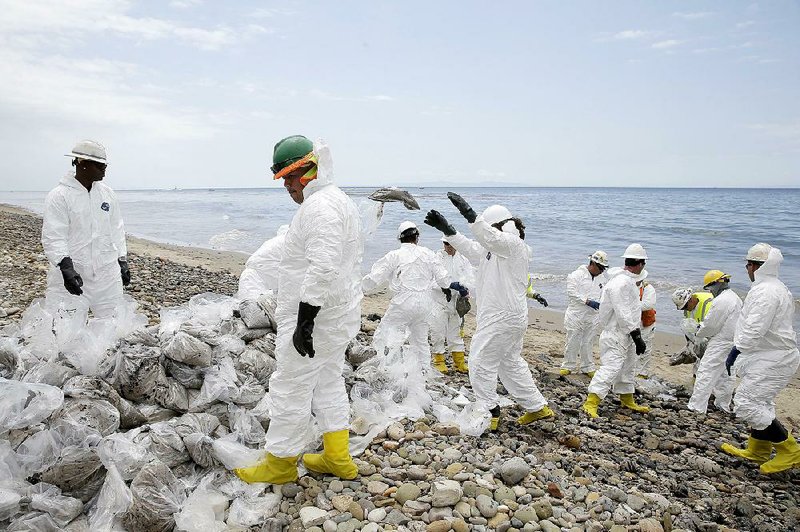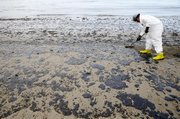GOLETA, Calif. -- More than 9,000 gallons of oil has been raked, skimmed and vacuumed from a spill that stretched across 9 miles of California coast, just a fraction of the sticky crude that escaped from a ruptured pipeline, officials said Thursday.
Up to 105,000 gallons may have leaked from the pipeline Tuesday, and up to 21,000 gallons reached the sea just northwest of Santa Barbara, according to estimates from the pipeline operator.
The environmental impact was still being assessed, but there was no immediate evidence of widespread harm to birds and sea life.
The early toll on wildlife included six oil-coated pelicans and one young sea lion, which were taken in to be cleaned, officials said. Biologists counted dead fish and crustaceans along sandy beaches and rocky shores.
The spill occurred along a long, rustic coast that forms the northern boundary of the Santa Barbara Channel, home to a rich array of sea life. Whales, dolphins, sea lions, seals, sea otters and birds use the waters between the mainland and the Channel Islands, five of which are a national park surrounded by a national marine sanctuary.
Workers in protective suits shoveled black sludge off beaches, and boats towed booms into place to corral two oil slicks. The number of cleanup workers surpassed 300, and the number of boats working the slicks rose to 18, officials said.
They could get help from expected light winds and calm seas, said Sean Anderson, an environmental scientist at California State University, Channel Islands.
"When the water's choppy, the response gets complicated. But since the water's nice and flat, the oil sticks together and it's easier to spot and easier to pick up," he said.
Coast Guard Capt. Jennifer Williams said the slicks were moving seaward, not toward other beaches.
Regulators and workers with Plains All American Pipeline LP, which runs the pipeline, aimed to begin excavating the pipe Thursday to get their first look at the breach. The company also was removing contaminated soil.
Federal regulators were investigating the cause of the leak and the pipe's condition.
The 24-inch pipe, built in 1987, had no previous problems and was thoroughly inspected in 2012, according to the company. The pipe underwent similar tests about two weeks ago, though the results had not been analyzed yet.
Company officials said it can take weeks or months after excavation and inspection of the broken pipeline to determine the cause of the spill.
Plains All American and its subsidiaries operate more than 6,000 miles of hazardous-liquid pipelines in at least 20 states, according to company reports filed with federal regulators. Those companies handle more than 4 million barrels of crude and other liquid fuels daily.
Since 2006, the companies have reported 199 accidents along their lines and been subject to 22 enforcement actions by federal regulators. The accidents resulted in a combined 725,500 gallons of hazardous liquids spilled and damage topping $25 million.
Corrosion was determined to be the cause in more than 80 of those accidents. Failures in materials, welds and other equipment were cited more than 70 times.
Enforcement cases against the companies resulted in the collection of $154,000 in penalties, according to a federal enforcement database.
Patrick Hodgins, senior director of safety for Plains All American, said the company has spent more than $1.3 billion since 2007 on maintenance, repair and enhancement of its equipment.
"Safety is not just a priority; it's actually a core value at Plains," he said.
Soiled beaches and the powerful smell of petroleum led officials to close popular campgrounds at Refugio and El Capitan state beaches through the Memorial Day weekend. A 23-mile by 7-mile area was closed to fishing.
The coastline was the scene of a much larger spill in 1969 -- the largest in U.S. waters at the time -- that is credited with giving rise to the U.S. environmental movement.
Environmental groups have used the latest spill as a new opportunity to criticize fossil fuels.
"What we see from this event is that the industry still poses enormous risks to an area we cannot afford to lose," said Joel Reynolds of the Natural Resources Defense Council.
Information for this article was contributed by John Antczak and Matthew Brown of The Associated Press.
A Section on 05/22/2015


